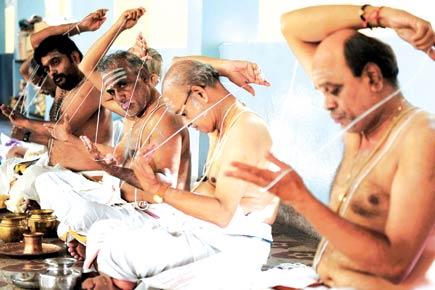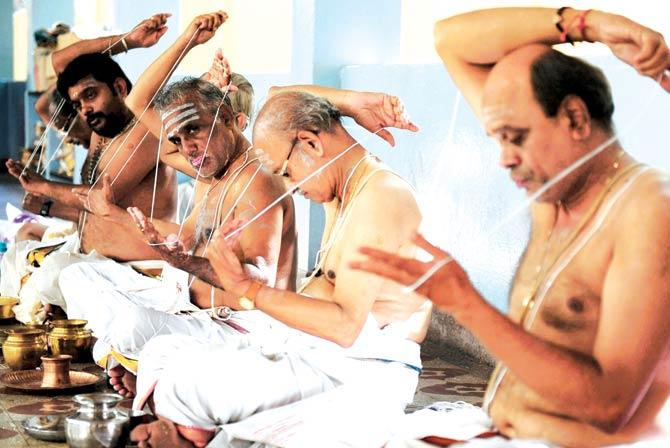RK Narayan's books used the power of storytelling to address many social evils, but he ignored the biggest one of them all - Casteism

The TamBrahm community takes part in a ceremony to change their sacred thread in Chennai. The main cast in RK Narayan's books is all TamBrahm. Pic/AFP

The TamBrahm community takes part in a ceremony to change their sacred thread in Chennai. The main cast in RK Narayan's books is all TamBrahm. Pic/AFP
 Last week, in writing about Bob Dylan and the Nobel Prize, this column mentioned the late RK Narayan and said he ought to have won the Literature Prize (even some influentials in India lobbied on his behalf while he was alive). Mentioned were his deceptively simple prose, his Chekhovian world of Malgudi in which places and characters recur, and the profound themes that his writing mined. Some readers responded positively. There was one friend from Chennai, BJK, who was so filled with indignation that he sent me a lengthy WhatsApp.
Last week, in writing about Bob Dylan and the Nobel Prize, this column mentioned the late RK Narayan and said he ought to have won the Literature Prize (even some influentials in India lobbied on his behalf while he was alive). Mentioned were his deceptively simple prose, his Chekhovian world of Malgudi in which places and characters recur, and the profound themes that his writing mined. Some readers responded positively. There was one friend from Chennai, BJK, who was so filled with indignation that he sent me a lengthy WhatsApp.
ADVERTISEMENT
BJK decried the casteism of Narayan's books. His writing ignored the existence of Dalits, and generally anyone other than the Tamil Brahmin. It was a travesty because in every village there were a multitude of castes, and in the 1940s, when several of his novels were written, the social fractures were especially stark. (They remain stark today.) While interacting with non-Brahmins, TamBrahms would not even address them by name but instead by their caste: for instance, they might call, "Hey Chettiar!" to a trader.
What BJK said was no doubt true, but even if Narayan did not write with social realism or social responsibility that did not undermine the craft and beauty of his writing. No one can take in all of humanity in a work of art, or in their canon. If Renaissance painters had plump women as their subjects, their neglect of emaciated, impoverished, non-urbanised women did not mean their oil paintings were any less as works of art. Even Western novelists did not capture society in its entirety until the Russians came along — take Chekhov's brilliant characterisation of the peasantry, or even Tolstoy wandering the battlefield from a dog's point of view in War and Peace. It took Charles Dickens to break through and write about London's underbelly.
You're right, BJK agreed. "But go pick up a novel of Narayan's and re-read it," he said. And pay attention to caste.
On my bookshelf I pulled at random two decades-old publications: Mr Sampath, The Printer of Malgudi, set in the mid to late 1940s, and The Painter of Signs, set in 1972. My first reaction on re-reading them was that I was in splits. Narayan writes much like his brother RK Laxman's cartoons — with a few brushstrokes he gives you a vivid portrait of a recognisable personage from small-town or rural India. Spouting wry observations, the characters seem to, in their thoughts at least, subvert conventions of piety and proper manners.
But BJK is right. The main cast is all TamBrahm. The children in the streets and in the background have neutral names. Even the love interest in The Painter of Signs, Daisy, turns out to be originally from a "good" TamBrahm family. She contributes to the novel's despondent ending. And the food in the novel is always vegetarian. The reality of villages is that most people are meat-eaters; they are not bound by purity issues, unlike the TamBrahm. During my four-year stay in Chennai I noticed that not only is biryani ubiquitous, but that biryani foodcarts are commonplace.
This seemed like another similarity between Narayan and Laxman: that while their common man gives the impression of being everyman, with his modest dress, his Gandhian spectacles and the umbrella tucked under his arm, he is an everyman only for the urban middle-class, acidly observing middle-class problems. Unstated is the fact that he is not lower caste. The common man is thus not so common.
Narayan's writing remains enjoyable: it is sweet and funny and sad, like all great writing usually is. But he failed to ever examine the omnipresent phenomenon in his society, caste, something one can not turn one's eyes away from. Thus, as BJK says, "He deliberately overlooked the caste dynamics of rural Tamil Nadu." One can sum up the attitude of caste's beneficiaries with a quote recently circulating US news sites: "When you're accustomed to privilege, equality feels like oppression." A friend recently published a novel in which the main character, modelled on herself, says that she was never caste-conscious because it was never an issue while growing up. She is a higher-tier UP Brahmin.
TamBrahms, though only three per cent of the state's population, similarly feel oppressed, though they control the popular narrative, projecting Tamil Nadu as filled with pious, vegetarian, musically-minded engineers. When I was an editor in Chennai, most people I met in academics or professional life were TamBrahms. Narayan's greatest champion was an Iyengar family that owns a national newspaper. Narayan may have tried to deal with social evils like religious superstition or overpopulation in his novels, but that was of little good because he never went to the root cause of social evil in India: caste. It's probably just as well that he wasn't awarded the Nobel Prize.
 Subscribe today by clicking the link and stay updated with the latest news!" Click here!
Subscribe today by clicking the link and stay updated with the latest news!" Click here!







